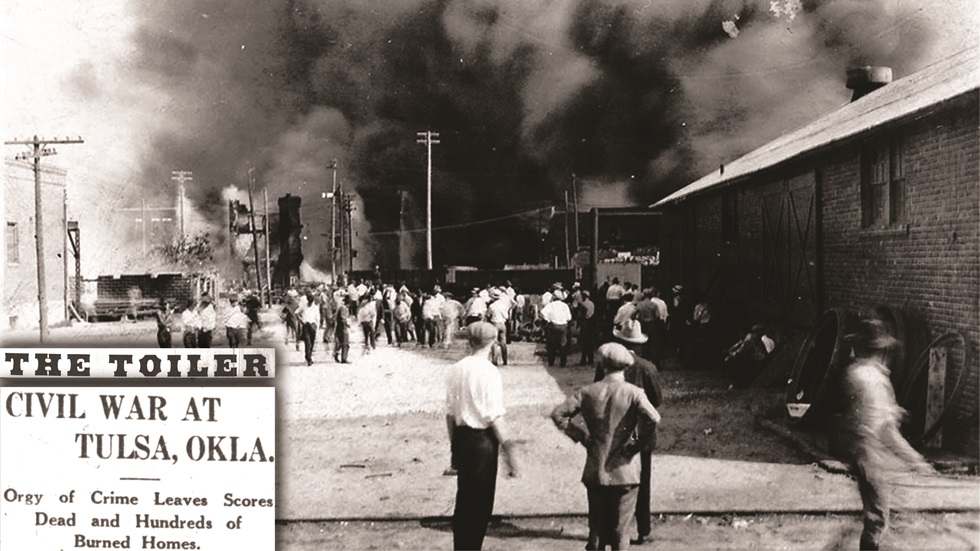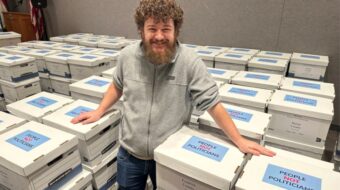
CHICAGO—One hundred and three years after they and their parents had to flee for their lives, Viola Fletcher, now aged 110, and Lessie Benningfield Randle, now 109, still seek justice for Tulsa’s Greenwood Massacre.
And via DeMario Solomon-Simmons, the lawyer for those two survivors and descendants of other massacre survivors, they brought their case to Chicago during the Democratic National Convention.
“Justice for Greenwood is justice for the whole Black community in general,” Solomon-Simmons told a panel discussion during the conclave, but separate from official meetings. “A whole community of 10,000-12,000 people and 40 blocks can be destroyed, and more than $300 million in property damage occurred” and nothing has been done.
Before the Massacre, Tulsa’s Greenwood District was not only the center of Oklahoma City’s African-American community and its cultural, civic, and business life but was one of the most thriving Black business districts in the U.S. It was called “The Black Wall Street.”
Then, on May 31-June 1, 1921, everything changed. And Black Tulsa still hasn’t recovered.
According to a history compiled for museums in Tulsa, a young Black man, Dick Rowland, was riding in an elevator downtown with a white woman, Sarah Page. Accounts of what happened between them vary, but Rowland was charged with attempted rape. Later, much later, the charges were dropped. But what happened after his arrest was a massive fire.
White lynch mobs, incited by editorials in the notoriously right-wing Tulsa Tribune and condoned by city officials, the police, and the Tulsa Chamber of Commerce, attacked Blacks in Tulsa’s streets. Jim Crow and racism drove the mobs. Blacks retreated to Greenwood, with some hastily arming themselves.
But the mobs were too large. The police and, later, the all-white Oklahoma National Guard stood by and did nothing, or joined the mob. The governor also armed the guard with machine guns and sent airplanes to bomb Greenwood.
Greenwood was looted and burned. More than 30 city blocks were damaged or destroyed. The official death toll—all of them Black—was 36. The real death toll, including those missing and unaccounted for, starts at 300. More than 800 Blacks were injured. Some 1,256 homes went up in flames.

So did everything else: Churches, schools, businesses, two newspapers, doctors’ offices, a YMCA, an opera house, a hospital, and a library. And 6,000 Blacks were arrested and interned.
“I hear the screams. I have lived through the massacre every day,” Viola Fletcher told National Public Radio three years ago, on the centennial of the massacre. “Our country may forget this history, but I cannot.”
Racial tensions remained in Tulsa. “My grandfather worked as a trash man,” Solomon-Simmons said.
“Many times he had to stay up all night with a shotgun, protecting his family.”
And what’s happened in the century since the massacre is massive denial, Solomon-Simmons told the session, hosted by the Emmitt Till Foundation—an organization memorializing another Black victim of a white lynch mob. Till, a teenage Chicagoan, was visiting relatives in Drew, Miss.
Denied they even happened
For decades, white Tulsa, and white Oklahoma, denied the massacre even occurred. Suits for damages were dismissed. Histories of the state and the city omitted it. Tulsa native Solomon-Simmons, a graduate of the University of Oklahoma Law School, said he learned about the massacre only there, 19 years ago.
Finally, seven years ago, the city set up a commission to re-investigate the massacre. It confirmed the facts and issued recommendations. The Oklahoma legislature ignored them.
That doesn’t satisfy the two remaining survivors—a third, Hughes Van Ellis, aged 102, died this past October—or their “children, grandchildren and great-grandchildren,” Solomon-Simmons said. They want official acknowledgment and reparations, not just from the city but from the state and the Chamber of Commerce.
But the Oklahoma State Supreme Court dismissed the case this past June. Its majority ruled the statute the survivors used to sue for damages “does not cover this case.” Solomon-Simmons is considering an appeal, to the U.S. Supreme Court. Given the current Republican-dominated High Court, that may be futile, but nobody at the Chicago panel discussion said so.
“Those whose lives were destroyed and their descendants have been paying taxes for 100 years,” Solomon-Simmons said during the panel discussion after a film about the massacre. “There should be reparations for those 100 years.”
After all, Oklahoma’s then-governor, Southern Democrat James B.A. Robertson called out the National Guard, whose members, all white, either stood by while Greenwood burned or helped fan the flames, the historical record shows. Then they arrested and interned the Blacks.
“The very people who burned our community rejected our case,” Solomon-Simmons said.
Three remaining survivors, plus Solomon-Simmons, finally got a U.S. House committee hearing, seven years ago, and passage of legislation ordering the Department of Justice to reopen the Tulsa Massacre case as a hate crime. But there’s been no action by Democratic President Joe Biden’s DOJ.
That led to the panel during the convention, though it was not part of the official program. One questioner asked: “They say ‘You gotta be quiet. They’re on our side,’” meaning the Democrats.
“They have to do things that demonstrate they’re on our side,” Solomon-Simmons replied.
One problem the panel admitted: The Justice Department is reluctant to investigate long-ago crimes unless prosecutors believe they have enough evidence to make a case against specific perpetrators.
“This is about more than investigating violence,” replied another panelist, a former aide to Rep. Al Green, D-Texas. “This is about the power to get justice. If we can get them”—the Justice Department—“involved, then at least we can have answers to the unanswered questions about Greenwood.”
ARCHIVES: Read our original coverage of the 1921 Tulsa Race Massacre.
We hope you appreciated this article. At People’s World, we believe news and information should be free and accessible to all, but we need your help. Our journalism is free of corporate influence and paywalls because we are totally reader-supported. Only you, our readers and supporters, make this possible. If you enjoy reading People’s World and the stories we bring you, please support our work by donating or becoming a monthly sustainer today. Thank you!










